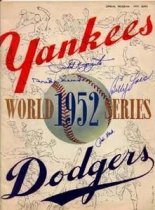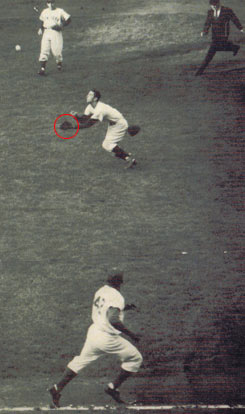The Revelation of How Much the World of Baseball and Medium of Television has Changed in More Than Half a Century

I happened to find a YouTube on my phone of the 7th game of the 1952 World Series.
The entire game.
That’s right.
Every minute of the telecast as it was presented in October, 1952 between the New York Yankees and the Brooklyn Dodgers.
Who wouldn’t smile and move on.
Not me.
Who would watch most, if not all of the two-plus hour game?
Me.
By now you’re wondering if I have too much time on my hands, and if I do, why in the world would I take the time to peruse a baseball game played 66 years ago?
Because I was curious. Curious as to how much the world of sports, baseball in particular, and the medium of television has grown and changed in more than half a century.
Frankly, it was a revelation.
Now, I am not one who longs for the good old days, who believes yesterday was better than today. In some respects things were better in the past, but not the kind of things that provoke today’s youth into accusing me of “just getting old”.
If you cling to the past, you ARE past your prime. But recognizing the past, and appreciating it, is a different story.
The national telecast of the 1952 World Series was sponsored by Gillette.
It was in black and white and it had absolutely no frills.
There were two announcers, both Hall of Fame greats. Mel Allen, the voice of the Yankees, and Red Barber, the legendary broadcaster who described Dodgers games during the regular season.
By the way, in those years, the Dodgers had a three-man crew.
Number three was a young redhead named Vin Scully.
The three never were on the air together.
There was only one voice describing the action and that’s the way it was on the Series telecast: Allen started the broadcast with brief pre-game
comments, then handed the mike over to Barber who handled the first four -and-a -half innings. Allen came back to do the last half of the game.
The cameras panned Ebbets Field in Brooklyn, the site of the deciding game of the Series, as well as the stands, the dugouts and the starting pitchers, who, in those days, warmed up on either side of home plate, not in their respective bullpens.
The chatter by Mel Allen was routine. No dramatic exclamations. Just emphasizing the fact that this one game would decide baseball’s world championship, and there would be no more games to be played after this one.
This theme was actually repeated countless times throughout the game.
It didn’t bother me. It kind of emphasized the reality of what was at stake and heightened the drama.
These were two great teams, with great players. Mickey Mantle, Yogi Berra, leading the Yankees. Jackie Robinson, Pee Wee Reese, and Duke Snider heading the Dodgers.
They were familiar World Series rivals in that era.
They clashed in 1941, 1947, 1952, 1953, 1955 and 1956. They were all memorable.
The Yankees were far and away the dominant team in the game, while the Dodgers, as superb as they were, had yet to win a World Series.
Would this be their first?
As it turned out they didn’t.
The Dodgers won the opening game, and the teams traded victories, until the final game.
The Yankees captured the last two in Brooklyn to win again.
The seventh game was a thriller. Mantle and Snider hit home runs (Snider hit four homers in the Series, tied for the second most in history), and the Yankees won 4-2.
Here’s what I liked about the presentation. There was minimal talk. The silence by the announcer and the murmur of the crowd, even during the lulls, simply built up the anticipation of what was to come.
The screen was not cluttered. There were no gimmicks, like a graphic around above home plate indicating whether a pitch was in the strike zone or not.
In fact, the now-routine shot from centerfield looking into the hitter from behind the pitcher didn’t even exist back then. Every pitch was seen on a high angle from behind home plate.
More often than not, ground balls to the infield would consist of one camera shot following the ball hit to an infielder, then widening to show the throw to first.
Funny, how we’ve gotten used to a centerfield view of a pitch, then a sharp cut to another camera from behind the batter, following the ball. If you were sitting in the stands, how could you ever make your head move from one view to another in that kind of a contrast as the camera is able to do?
On the subject of clutter, the only graphic on the screen was the name of the hitter when he stepped into the batters box.
That was it. No statistics, no facts, no history, no clutter.
I didn’t feel I needed it.
Today, it’s totally different. The multitude of information out there to read on the screen and hear from the announcer, is, frankly, overwhelming.
I often wonder how much of all the volume dispensed on sports broadcasts is actually digested and absorbed by viewers.
Do they really read all that stuff? Do they really hear every word the announcer is saying, filling every second of every game?
Or do those who watch, basically watch, and not pay attention to all the other stuff.
The one major aspect to that 1952 telecast, that viewers could never get along without, was the absence of replays. Today, it is the staple of every game on television.
It’s why many would rather watch at home than sit in the stands, although those huge Jumbotrons give everyone on hand a second view.
In the eighth inning of the deciding game, the Dodgers, trailing by two runs, loaded the bases with two out.
Jackie Robinson was at the plate. Perhaps the Dodgers last big opportunity. Robinson lifted a medium pop-up to the first-base side of the pitchers mound that was about to fall for a hit that would very well tie the game.
But Yankees second-baseman Billy Martin charged in, full speed, and caught the ball a foot from the ground. It ended the last Brooklyn threat, and Martin kept running into the Yankee dugout.

That play remains as one of the most remarkable and timely defensive plays in World Series history. I was waiting for the replay that never came. It didn’t, because it hadn’t been invented yet.
Today, we would have seen five separate angles of the catch.
I believe we live in a time of clever, and entertaining sports production. Color, music, and nifty editing, really only enhance the anticipation and overall enjoyment of an event.
Drama builds for the big game from the very start of a broadcast. The view from the sky of a stadium or arena, at night with the surrounding view of the city is breathtaking.
The appropriate music, shots of the participants and the authoritative narration by the announcer only adds to the enormity of the contest to follow.
However, I continue to believe, that during the game, as we see the unmatched, unscripted developments unfold, the best way to take in the events we will remember for years, is to anticipate them, enjoy them, and be moved by them, without being engulfed by words and numbers which dominate the screen, and loud, voluminous, unnecessary chatter by the announcers.
It’s television.
Let’s see the pictures and hear the crowd. What more do we really need?
